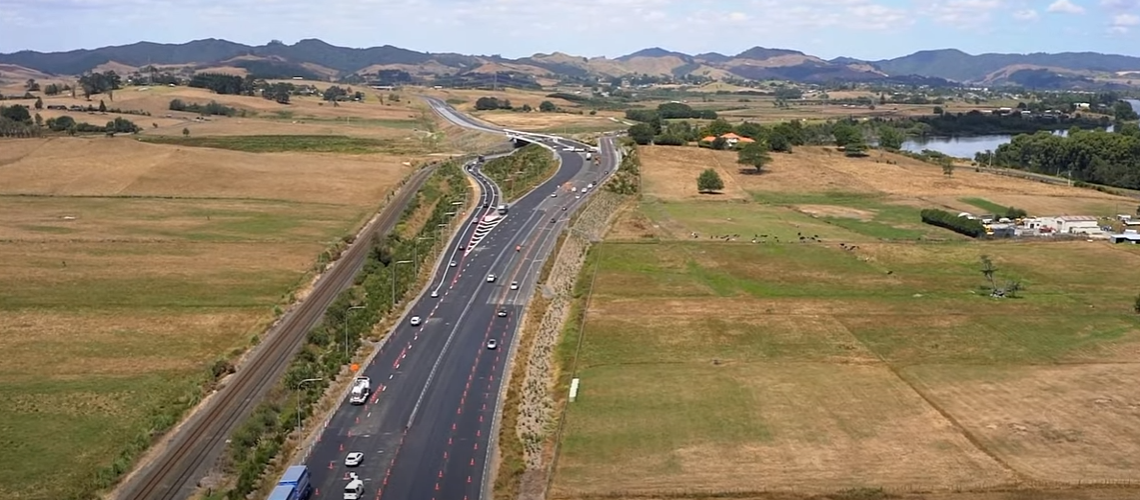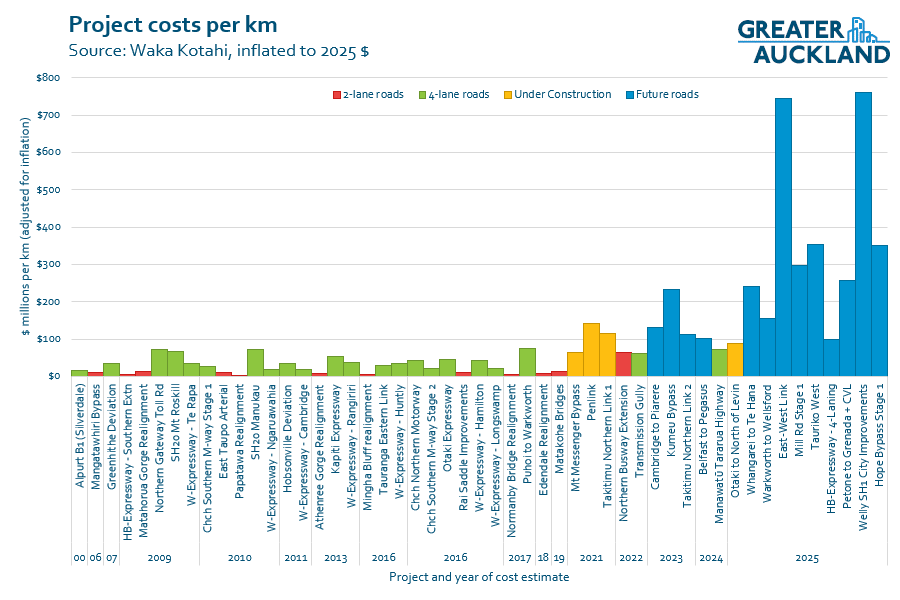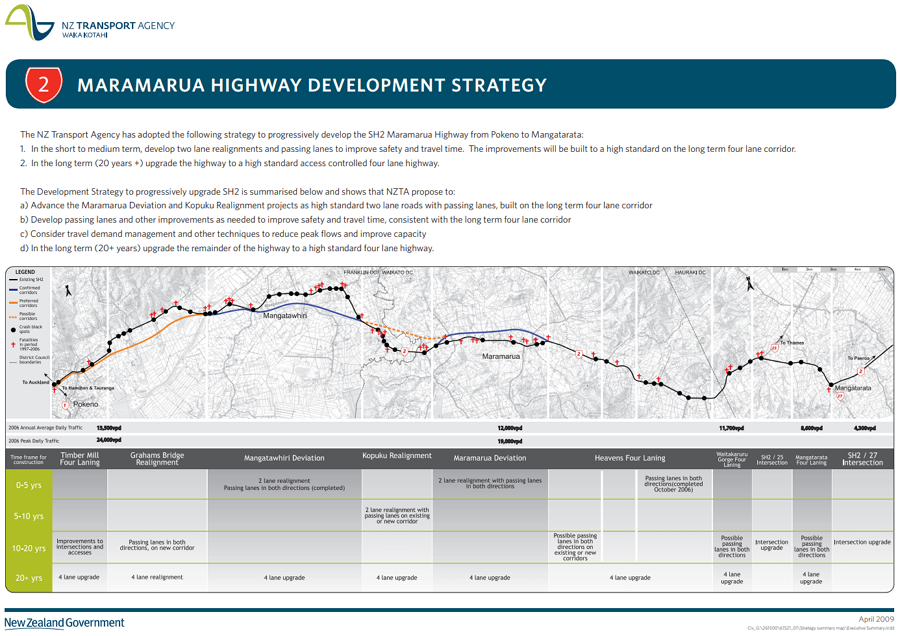The absurdly high cost – potentially $50 billion – of the government’s focus on building MOAR RoNS (Roads of National Significance) was highlighted last week, with the release of new costings for six of the 17 projects.
I covered some initial implications in a first post, Reality Bites: RoNS will bankrupt the nation.
Since then, I’ve had a few additional thoughts on the projects, some of which I’ve assembled below.
Wild cost inflation
One thing that really stands out with these projects is just how expensive they are. It wasn’t all that long ago when a really expensive transport project would cost a few hundred million dollars. Now even seemingly straightforward projects seem to cost at least a billion.
(Note: a billion is a thousand times a million. A million seconds adds up to 11 and a half days; while a billion seconds is over thirty years. Here are some handy visuals of the difference in scale. See also this great scrollable version.)
Below is a chart I’ve used a few times before – I didn’t have time to update it for my last post, but I have now. It looks at how much transport projects cost per km. For this version, the costs for projects completed in the past are inflated to 2025 dollars to give a better comparison.
A few things stand out:
Prior to the arrival of COVID, four-lane motorway/expressway projects would cost $20-70 million per km, with most being less than $50m and the median being $34m. Those at the upper end were the more recent ones like Puhoi to Warkworth ($73.7m), Transmission Gully ($61.7m) and Te Ahu a Turanga–Manawatū Tararua Highway ($73.2m).Otaki to North of Levin – which has just started construction – is the cheapest of these new RoNS projects at $87.5m; the rest are coming often well above $100m per km.Back in 2017, the East-West Link was estimated to cost $1.8 billion, or $327m per km. Back then, it was billed by the infrastructure lobby as one of the most expensive roads in the world – they even compared its cost to a corruption-ridden road in Russia. It is now estimated to cost up to $4.1 billion… for a smaller version of the project.However, the East-West Link has now been pipped as the most expensive of all RoNS [ed: and thus the most expensive roading project in New Zealand history, and possibly the world?] by the SH1 improvements through Wellington, which include a second Terrace Tunnel and second Mt Victoria Tunnel.**Updated 9.30am: The Post reports today that NZTA has gone around Wellington City Council to send notices to around 200 properties expected to be affected by this project. Pukehinau/ Lambton ward councillor Geordie Rogers is “incredibly disappointed”, with the secretive approach, highlighting concerns about the impact on traffic volumes through the heart of downtown. Wellington. Rongotai MP (and Green transport spokesperson Julie Anne Genter) notes the project – which has “the worst cost-benefit of all the RoNS nationally” – remains unfunded beyond the planning and property acquisition stage.
Back to the question of cost escalation: given the cost inflation we’re seeing on transport projects, it’s a good thing the CRL didn’t get delayed more than it already was, I’d hate to think what the cost would be if we were starting it today. That said, you could also say the CRL is looking like incredibly good value if you were to compare it to some of these projects.
As I highlighted last week, these road projects have managed to generate a Benefit Cost Ratio of over 1 thanks to changes in how the BCR is calculated, with longer assessment times and lower discount rates. I wonder what the BCR of the CRL would be under these new rules?
An obvious question is, what can be done to get these project costs back down to somewhat sensible levels? Getting them back to where things were before COVID would see them collectively costing closer to $10-15 billion. That’s still a lot of money – but certainly a more reasonable figure.
Note, these are the costs National claimed for the projects in 2023:
How Fast?
The claimed benefits for the Whangarei to Te Hana project note that it will be up to 38 minutes faster. The road is about 75km long, and Google tells me that most of the time it takes about 58 minutes to drive this distance. In this context, saving 38 minutes would be a massive amount – but it also equates to vehicles needing to average over 200km/h which doesn’t seem all that safe
Time for a rethink?
Maybe it’s time for the government to rethink its MOAR RoNS policy. Maybe Nicola Willis could even save some money by recycling her first ever press release as the Minister of Finance. It would only need a few tweaks:
The coalition Government has declined a KiwiRail NZTA request to contribute significant additional funding to address cost escalations in the project to replace the Interislander ferry fleet Roads of National Signifance programme, Finance Minister Nicola Willis says.
KiwiRail NZTA had requested an additional $1.47 $30 billion, a component of which had been agreed to in-principle by the previous government, to address cost escalations related to associated harbourside infrastructure.
“The Government remains committed to a resilient safe and reliable Cook Strait connection road network, but the cost of this project programme has almost quadrupled since 2018 2023 to approximately $3 $50 billion,” Ms Willis says.
“It is also now the case that only 21 per cent of these costs are associated with the core project of replacing ageing ferries.
“Ministers do not have confidence that there will not be further increases and are concerned about the continued significant cost blow-outs and the changing nature of the investment they are being asked to make.
“Furthermore, agreeing to KiwiRail’s NZTA’s request would reduce the Government’s ability to address the cost pressures that are impacting on New Zealanders, fund other essential projects and get the Crown’s books back in order.”
All jokes aside, that $3 billion for the ferries and new harbourside infrastructure is looking pretty good now when compared to the cost of many of these projects. And frankly, it’s no joking matter that $50 billion is vastly more than the $1.47 bn that allegedly broke the bank.
What misses out, when RoNS are hoovering up all possible investment?
One of the problems of spending (or even dreaming of spending) so much of our collective wealth on these massive projects is that it crowds out the funding for so many other, often more valuable projects.
It should be reiterated: the $40-50 billion price tag for the RoNS programme is significantly more than the amount available from existing transport funding, and so most of the money will need to come from the government. That’s our money that could otherwise be spent on things like hospitals and schools.
Even if you devoted that colossal amount of money to just transport spending, it could build significant portions of the active and rapid transit networks our major cities desperately need to give people real alternatives in how they get around – in the process significantly improving health, safety, environmental and productivity outcomes.
There will even be a lot of good road projects out there which will not be as expensive (nor as politically glamourous) as a big motorway project, but which have higher benefits. A package of these kinds of projects could deliver significant value, especially if they help improve road safety.
This includes things like minor highway realignments, safety barriers, intersection upgrades, and even small bypasses of towns. These are the kinds of projects which have had money and resource sucked away from them to help pay for the RoNS.
I was reminded of one of these while travelling over the weekend: the upgrades to SH2 around Maramarua as described in my 2016 post, A Good Highway Upgrade.
This project has been planned and then stopped several times over the last decades. What’s particularly of interest to today’s discussion is this document from 2009, which highlights how the upgrades could be achieved in stages, starting with bypasses and safety improvements and new passing lanes.
This is exactly the kind of smart, prudent approach that should be being taken with most of these RoNS. And maybe it would be if the government weren’t so busy mandating projects and controlling detailed design outcomes.
(For example, that 2016 post included this quote from then minister Simon Bridges: “We also want to provide safer choices for cyclists and ensure local people have safe access to their homes, schools and businesses” – sensible benefits that are now likely out of scope, after Simeon Brown’s unprecedentedly hands-on revamp of transport funding policy.)
The Maramarua project did get funding again in 2016, but it was put on hold again a few years later. Would it – or other possibly higher-value projects – be already built now if transport planning hadn’t been made so political?
What other vital projects like this are missing out on funding and delivery, due to the focus on RoNS?
This analysis, like all our work, is brought to you by the Greater Auckland crew and is made possible by generous donations from our readers and fans. If you’d like to support more of this work, you can join our circle of supporters here, or support us on Substack.
Postscript: related coverage of the RoNS blowout
Bernard Hickey, The Kaka: The problem(s) with the RoNS and tolls, 22 October:
This is just time-wasting magical thinking that only enables us all to avoid the hard realities.
Blayne Slabbert, The Press: South Island receives just 6% of 1.2bn road funding package, 22 October:
In this round, the lion’s share is going to motorway corridors in the North Island, including Auckland’s East West Link, the Hamilton Southern Links, a new Mt Victoria Tunnel in Wellington and further upgrades in Northland.
Marc Daalder, Newsroom: $5b-plus blowout for eight Roads of National Significance, 23 October:
The total anticipated bill for the Government’s 17 Roads of National Significance has swelled to an estimated $44 to $54 billion – a gargantuan figure more than 23 times the cost of the Dunedin Hospital rebuild.
Joel MacManus, The Spinoff: We’re spending all our money on roads that suck, 28 October:
…the government is obsessed with finding fancy new ways to fund big infrastructure projects. But the far, far bigger problem is that the government keeps building roads that suck.
The New Zealand government is now basically a road-building authority with bits tacked on.
David Slack, More Than a Feilding: Chris Bishop takes his noble beasts for a drive, 28 October:
Even though The Infrastructure Commission laid it on the line: this one single project will consume 10% of the nation’s entire infrastructure budget, not just roads, everything) for the next 25 goddamn years; this government of asphalt-loving car-humpers stared back unblinking and said: Sounds good, let’s do it.
And various folk have been doing the maths on social media: the current $18bn price tag for the Northland Expressway alone is six times the cost of the Cook Strait crossing upgrade, or 327 times what the government spends on basic science; a thousand years worth of Creative NZ funding; the Wellington project equates to light rail in Welly plus making the whole of the South Island SH1 safer; the whole RoNS programme could build 150,000 state houses, etc.
Share this





